|
This review page is supported in part by the sponsor whose ad is displayed above
|
|||||||||||||||||
 |
|||||||||||||||||
 |
|||||||||||||||||
Reviewer: Kari Nevalainen Analogue source: La Nouvelle Verdier with Ortofon RMG-309, EMT 930 with RF-297; Ortofon SPUs, Denon DL-103 and other cartridges Digital Source: Audiomeca Kreature transport, Sentec DiAna DAC with various mid-fi digital cables Preamp: Shindo Aurieges, Dynaco PAS (heavily modified) Power Amp: Shindo Montille, 6V6 DIY design, Sony integrated Speakers: PHY/Fostex based wide bandwidth single-driver speakers Cables: PHY, Kimber, Belden, Supra Power cords: Generic Accessories: Sound Organisations rack, Gregitek equipment platforms; Final, SID and other isolator pads Mains treatment: None. Room Size: 4.5m wide by 5m long by 2.8 m high, one side wall partly open Review component retail: €4990 incl. VAT |
|||||||||||||||||
 |
|||||||||||||||||
My right to eat my salad, when that right is not exclusive, only means that I'm under no obligation to eat the salad or not. It specifically doesn't imply that others are obliged to not interfere. However, when my right to my salad, shoes or CD player is exclusive, I have all the reason in the world to do anything I like with it while others have no right to intervene. It's mine. I own it. The Italian Labtek Exclusive digital player reminded me of a far nobler sense of being exclusive than any of that. Not only is the player mine, it was specifically crafted for me. Well, for me and 29 others. Only 30 pieces of this player are intended to reach the assembly line. All machines are numbered and the owner's name is engraved on a brass nameplate. An included certificate declares that only 30 will be produced. The player for the review had my name on it, not because the player would be mine now or later but because I consented to the manufacturer's request that the review would double as reality check for how things would proceed in practice with an international customer. |
|||||||||||||||||
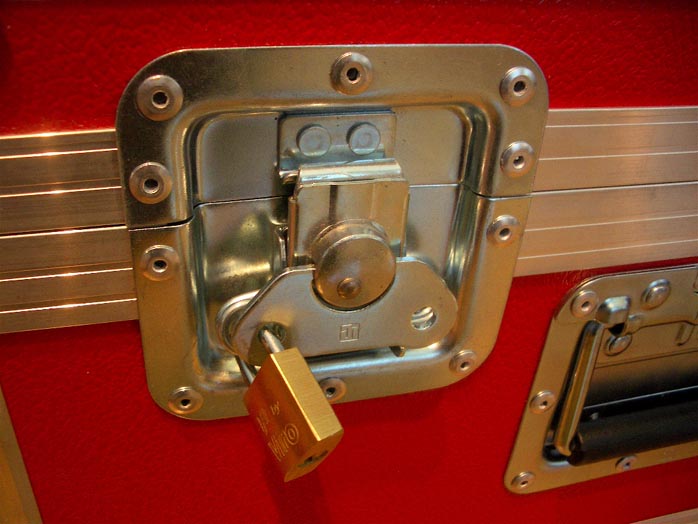 |
|||||||||||||||||
All went fine. The player arrived as agreed in an imposing red flight case that was locked. The keys came by separate envelope. Inside the case, everything -- the tubes, the feet for the vibration control platform, the thick power cord, the gloves etc. - was in impeccable order. This is how proper packaging is done, period. |
|||||||||||||||||
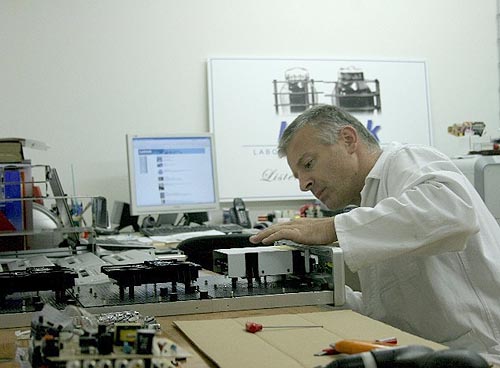 |
|||||||||||||||||
| No reason to turn sentimental but, there's something special to this player and one can feel it from the very first moment of lifting out the machine from its case. For one thing, the Exclusive is exceptionally heavy for a digital player. It's not as heavy as my Telefunken M5 tape recorder from the 50s but it gives off similar military | |||||||||||||||||
| vibes. The player looks gorgeous but more importantly, it feels so too. Every detail was paid attention to not in the standard 'hand made' but true artisanal "crafted by a master craftsman" way. It's personal. It exudes craftsmanship and individualized perfection. If you place an order on Monday, don't expect delivery by Friday. A player like this is not completed in a day or two. |
|||||||||||||||||
 |
|||||||||||||||||
A specific English manual was missing (I'm told it's being translated) but fortunately, prepping the player for work was almost plug 'n' play. The power cord went where it did, the tubes into their sockets and that was that. The latter calls for a bit of courage and thin fingers but once done, the player provided ease of use (either from the front panel or remote) and trouble-free weeks of music listening. The transport section makes a small spinning noise but the level is perfectly subdued when the ear is not hovering close. Less digital, more mechanics The reading mechanism, 24/192 converter and digital control logic are based on a Pioneer DV-696AV-S universal player. This explains the menu buttons on the front panel and the included Pioneer remote control. Props go to Labtek for not disguising the Pioneer name with an adhesive overlay. Working on a preexisting platform is common industry practice and in many cases well justified. You may not realize just how many high-end CD players are in fact worked-over Japanese machines. This doesn't invalidate the fact that a less expensive digital player in skillful hands couldn't t be turned into an excellent piece of electronics. It all depends on the hands. |
|||||||||||||||||
 |
|||||||||||||||||
The reason why Luigi Dall'Antonia, soul and body of Labtek, chose an available platform and didn't bother modifying the digital section is his belief that the true sonic problem areas in a CD player are the power supply, lack of vibration control and the output stage. Whatever problems might hide in the digital domain (e.g. jitter) can be effectively attacked mechanically. As for the power supply, it was the tubed output stage that caused Labtek the most grey hairs and headaches. Unlike for the digital section, the power demand of tubes is nonlinear. I was told that in search for stable, clean, fast and unlimited power on demand, many common solutions were abandoned and that in the end, Labtek developed their own HiPower module said to avoid problems typically associated with conventional coils and to guarantee adequate and appropriate power starting at 0Hz. The module houses selected components and is completely shielded in aluminium. The fight against vibrations was a giant concern for this player. Hardly any CD player manufacturer nowadays launches a new model without paying attention to vibration control (usually confined to the chassis however). But Labtek -- and the vibration specialists at Gregitek engaged in improving the player in this regard -- have taken vibration control to another level. Luigi and Gregorio are dead serious on the subject. Hence vibration control is not a mere aspect of this player, it's as essential as wings are to birds. |
|||||||||||||||||
 |
|||||||||||||||||
According to Luigi and Gregorio, the most critical section of a CD player with regard to vibration is the reading mechanism, in particular the laser focus lens. In a typical reading mechanism, the extremely light focus lens is suspended on springs and thus responds to the smallest external inputs to be constantly beleagured. To Luigi and Gregorio, this means bad for the sound. It became apparent very soon that it was impossible to solve this problem by dealing with the read mechanism alone. Instead, they suggested a series of measures was required, reconsidering the whole player afresh from the standpoint of vibration control. This is why all Labtek Exclusives arrive with the Gregitek STAB 1/AERIUS platform. |
|||||||||||||||||
 |
|||||||||||||||||
| The three feet are made of specially processed graphite known for its excellent damping properties. The feet are decoupled from the player via rubber rings and each foot may be adjusted separately to increase or decrease the coupling pressure against the player and to adjust the horizontal plane. The player is further isolated against external impact by its heavy aluminum chassis with a thick face plate plus accurately damped cover. Inside the player, the | |||||||||||||||||
| read mechanism itself is supported on graphite pillars (made from the same material as the feet) and the entire assembly is made heavier to increase resonance immunity, then encased in an amagnetic steel case itself treated against vibrations. These are just some of the measures Luigi and Gregorio have incorporated to provide ideal working conditions for the laser assembly. |
|||||||||||||||||
 |
|||||||||||||||||
All electronic boards are encased in non-magnetic and inert steel cases. The mains transformer is wrapped in a special rubber. The tubed output stage too suffers from unwanted vibrations if not treated properly. Labtek's approach was a spring-suspended, fully floating tube base. The output stage circuit (no negative feedback, parallel single-ended) is ultra simple and the signal paths are as short as possible. Each tube drives its own channel and the output impedance is set as low as possible to optimize the interface with most preamplifiers. The frequency bandwidth is said to exceed 200kHz limited only by the DAC. The select components are treated to maintain their characteristics within 1% of |
|||||||||||||||||
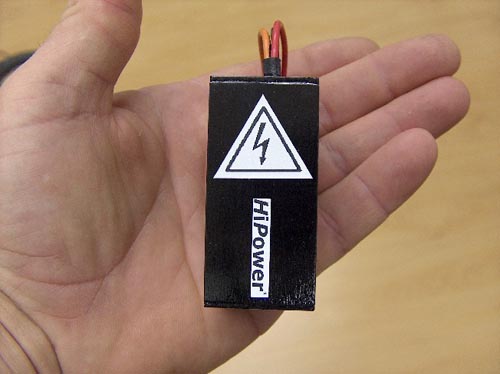 |
|||||||||||||||||
| tolerance for an indefinite period. The treatment itself is proprietary to Labtek. The simple circuit of the output stage means that the tubes carry a high responsibility for final sound quality. Sovtek 6N1Ps were chosen for their known reliability but Labtek generously admits that replacing the stock tubes could be a simple and efficient upgrade. It allows the customer to customize the player. All my listening observations are based on the Sovteks. Having been able to make a closer acquaintance with the Labtek Exclusive, I have good reason to believe that it's not just another high-end digital player stuck into a luxury chassis - if there are such beasts in the first place. What's important in a digital player and what isn't can always be debated but that a lot of thinking and testing have gone into designing this particular player cannot be disputed. I also admire the fact that Luigi is designing his own electronics like amplifiers and UPSs in accordance with future 2009 European norms. One such norm says that electronic devices must work with low operating temperatures and low power consumption. That's hopefully beneficial to the environment. |
|||||||||||||||||
| Soundwise The Labtek Exclusive is a universal or a multi-standard player as the fascia confirms. Not only does it support SACD and DVD-A but also video signals in all standards including HDMI. It also plays MP3, WMA and JPEG files. I left evaluation of the video performance out for obvious reasons of personal incompetence in that sector but also because I was advised that the Exclusive is designed to be at its best with CDs. I did briefly compare its SACD performance to CD playback with a hybrid recording of Mozart's Violin Concertos by Norwegian SACD specialist 2L. I wasn't too disappointed with the SACD performance. At least with this recording, the SACD layer was competitive and refined. All the evaluations were CD based, however. |
|||||||||||||||||
 |
|||||||||||||||||
| As always, I first compared the Exclusive with | |||||||||||||||||
| my resident Audiomeca/Sentec DiAna, not the best combo extant but one I know well. The very first impression was meteorological of sorts. The sound spread into the room and passed over my body like a warm föhn blowing over the Alps from Northern Italy into Switzerland. Without being phasey, the sound was everywhere and distinct from the loudspeakers, albeit in a different way than how the best speakers keep the sound away from their cabinets. This sound had an immaterial presence not in evidence with my own CD player. This quality clearly added listening pleasure to most music. |
|||||||||||||||||
 |
|||||||||||||||||
Labtek is particularly proud of the Exclusive's big broad sound such that I was warned to reposition my listening chair. I didn't and I'm not sure if such a difference is possible from a CD player but vis-à-vis all the CD players I compared, the Exclusive did tend to sound bigger both horizontally and vertically. I've noted that in the relevant literature, big sound frequently means two-dimensional. Did it? There are two separate questions here. Was the front-to-back spatial information on the record adequately revealed? It was. Was the soundstage thinned and set back horizontally like a woman with a big mouth but thin lips? It wasn't. Some people or CD players prefer the latter but that's not Labtek's choice for this player. Warm Mediterranean wind? People do believe that sound can be warm or cold, only metaphorically I hope. Metaphorically, the sound of the Exclusive is anything but cold and clinical (in comparison, my player sounded frigid and lifeless) but was it too warm or soft? This is of utmost importance. The balance is delicate and I therefore wanted to be very careful in getting the nature of the sound right in this respect. Not even tube lovers want to hear the tubes in the output stage - their goodies yes but not with a designer label. My conclusion after days and weeks of testing was that the tonal balance of the Exclusive has been tuned in good taste. The sound has a sophisticated and silky character, even a certain roundness but without being boring or veiled. The sound is neither overtly warm nor unintelligible. No small musical info is hidden yet the inner tone color references a tube-like character. |
|||||||||||||||||
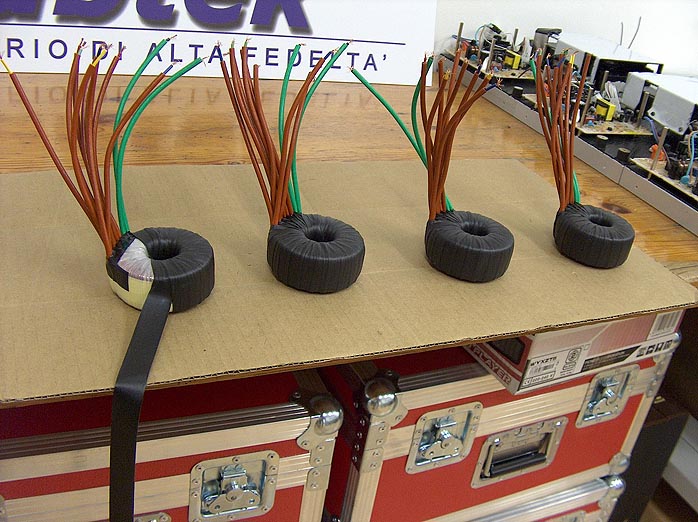 |
|||||||||||||||||
The best I can say about the vocal range is open. 'Open' in general is a good word for describing the sound of this player. Related to this, an interesting phenomenon happened when a chorus line began with a very sharp consonant sound: my player made the female singer hiss the word whereas the Exclusive appeared to let the singer sing the line despite the aggressive nature of the attack. I repeated this test several times (also with other samples) to arrive at the following generalization: the Exclusive was less edgy and nervous from the midband on up than my own player. The only area where it did not subjectively beat my player was in bass performance, not that its bass was slow or subdued. But if the measure is how accurately the listener can follow the bass line with small jazz music, the Exclusive was neither better nor worse than my machines. All things considered however, there was no question which player I'd choose purely on the basis of sound quality. Could a Sony XA9000ES over an Accuphase/Dunlavy system give the Exclusive a better run for the money? Not really. Yet the comparison was useful because it was drawn under controlled circumstances. I was able to match volume levels within 0.1dB, important because the output voltage of the Exclusive is exceptionally low compared to the standard. Moreover, the room had a fairly flat response plus the background noise level was 15-20 dB down from a typical city apartment. Under such conditions, differences between CD players tend to diminish rather than grow and to a certain extent, this is what happened. Still, the differences allowed no doubt that the Labtek Exclusive had a more analogue, refined and airy sound. The more difficult the music, the more complex the timbres, the bigger this difference became. |
|||||||||||||||||
| With some music like solo saxophone, the Sony brought the sound more forward which can mean either that the Sony had a tad more energy or distortion in the upper midrange or that the Exclusive was slightly too forgiving in this respect. Whatever the case, the Exclusive sounded more relaxed and less sharp over the highest octaves. With piano, the Exclusive was capable of equally dramatic and dynamic effects but I'd not be surprised, weird as this hobby is, if a fraction of piano music lovers actually preferred the Sony's direct and forward sound. The Exclusive's performance however was more to my liking. |
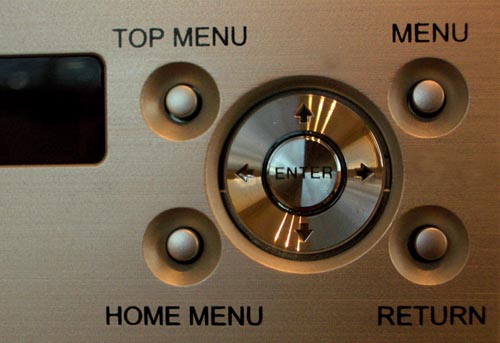 |
||||||||||||||||
| The Ayre C-5xe Universal 2-channel Audio Player at more than €6000 proved tougher competition. Ayre's is a solid-state player but apparently not one of those about which tube fiends get quickly irritated. I liked the performance of both players. Both gave full musical satisfaction with Usher amplification and Martin Logan speakers. If Ayre's sound was more neutral, the Exclusive sounded more airy, loose and open. One thing this comparison proved was that the Exclusive, metaphorically, breathes extremely well. The Ayre laid the sound entirely behind the speakers while the Exclusive presented the sound as a big balloon between the speakers. Which one to prefer would not be a matter of taste if the Exclusive's big billowy sound didn't contain plenty of spatial information including in the depth domain. But it did. The Exclusive is so much fun to listen to in so many ways. | |||||||||||||||||
 |
|||||||||||||||||
| Summary I don't drive an exclusive car. I don't hold a membership in an exclusive club. I always buy my shoes off the rack. But having been privileged to review the Labtek Exclusive certainly gave me clues about the mind set of those who are besotted with getting their shoes fitted by a bespoke maker. The Labtek Exclusive is a first-class digital player. It's superbly made. It looks and feels great. Its sound has many qualities and an overall sophistication generally not available with ordinary, less expensive players. And with the same money, you can further watch and listen to your music videos. If you decide to get one, you will be taken care of. Plus, you a get a player that's a collector's item from the day it was made. |
|||||||||||||||||
| "Hi Kari, I just returned from the TOP Audio Show. It was enormously hard work. I had to handle everything solo, from the transportation to the assembly of the system to running the show and finally take-down. I am most tired now. I enclose two photos of Belluno, the city where I live and work, because I am so happy to be back home again between my mountains. Now I take two days of rest." |
|||||||||||||||||
 |
|||||||||||||||||
| I'm grateful that Luigi sent me this piece of personal history as part of a reply to one of my queries. I cannot express enough admiration for these small entrepreneurs who dedicate their lives to designing | |||||||||||||||||
| and manufacturing products that, even if successful, remain marginal. That's seriousness and passion. Money of course is important to feed one's family and meet basic human needs but even a dog wouldn't do what these guys do unless there was that love for what you're doing. Again, there's no reason to turn sentimental but perhaps a small part of that love is really tangibly present in their products in some important way that will make an important difference to you? | |||||||||||||||||
 |
|||||||||||||||||
| Quality of packing: A stout flight case. Reusability of packing: Indefinite. Ease of unpacking/repacking: Very easy. Condition of component received: Flawless. Completeness of delivery: Complete. Website comments: The manufacturer's willingness and speed in responding was exemplary and whatever language problems existed in the beginning were remarkably eliminated over the review period. Warranty: Two years. Human interactions: Very pleasant. Pricing: Expensive although far removed from the most expensive digital universal players. |
|||||||||||||||||
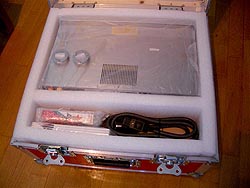 |
|||||||||||||||||
 |
|||||||||||||||||
|
Labtek's website
|
|||||||||||||||||
 |
|||||||||||||||||